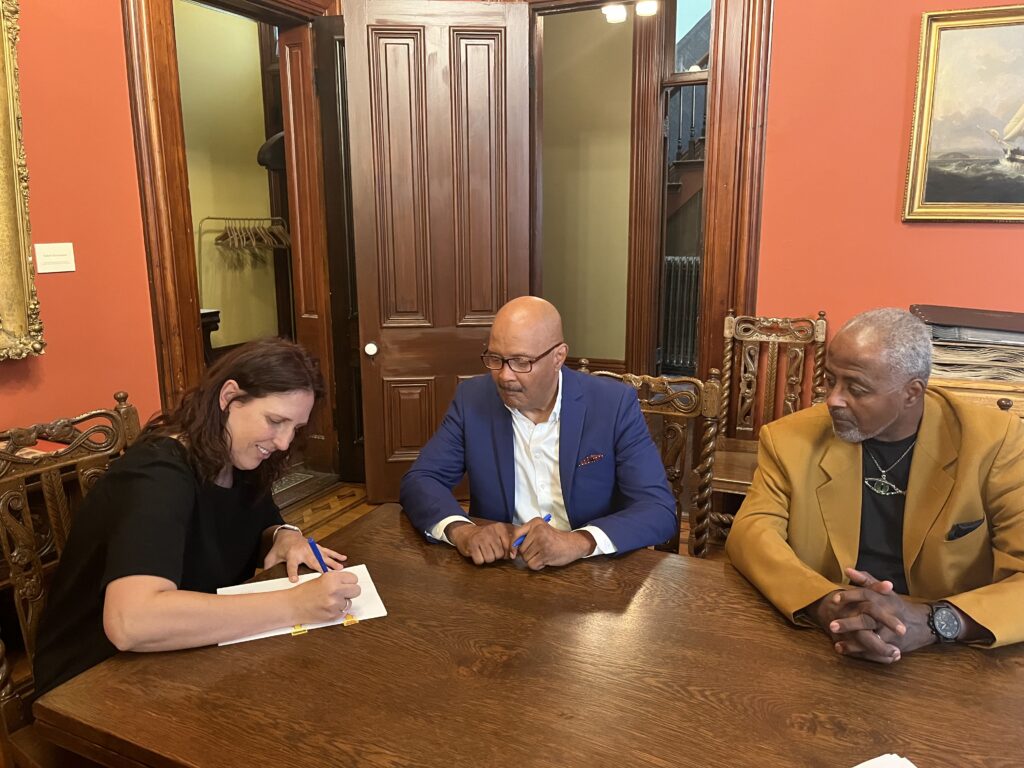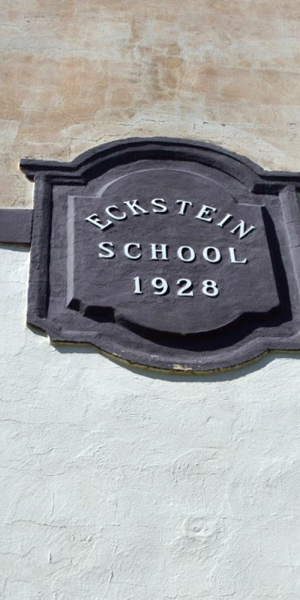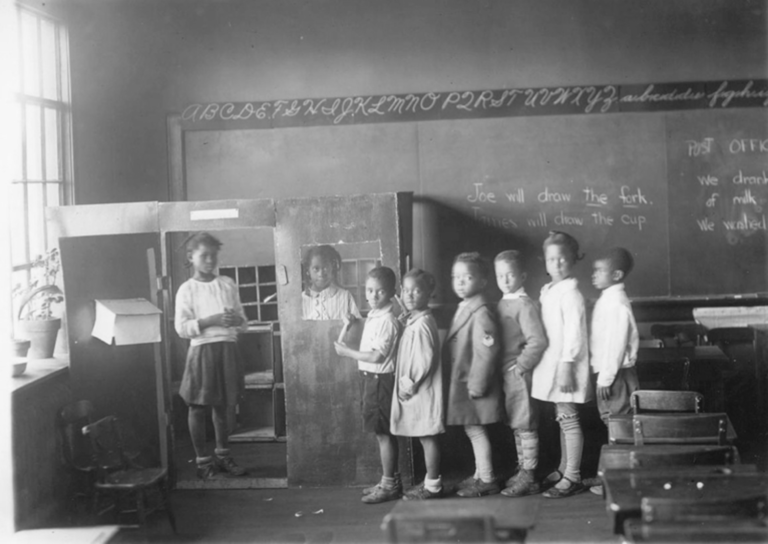
Update 8/14/24:
Cincinnati Preservation has transferred property ownership to Eckstein Cultural Arts Center, and applauds the organization’s stewardship and plans with the site!
Cincinnati Preservation Association Purchases Endangered School!
Eckstein School – Glendale, Ohio


Update 9/21/2021: Cincinnati Preservation Association Announces Agreement to Purchase the Eckstein School.
“The National Trust for Historic Preservation is pleased to hear that the Cincinnati Preservation Association has acquired the Eckstein School to protect and preserve this cultural asset important in Black American history,” said Brent Leggs, executive director of the African American Cultural Heritage Action Fund. “By acting as a steward of and champion for this historic site, the Association has set a blueprint for other local preservation organizations to model. We applaud their vision and dogged persistence in the name of racial justice.” Brent Leggs, Executive Director, National Trust for Historic Preservation’s African American Cultural Heritage Action Fund, 9/21/2021
Cincinnati Preservation Association Announces Agreement to Purchase the Eckstein School in the Village of Glendale, Ohio
Historic African American Elementary School was at Risk of Substantial Demolition
Today Cincinnati Preservation Association announced it has entered into an agreement for the purchase of the Eckstein School in the National Historic Landmark Village of Glendale, Ohio. It is with 42 Washington Ave., LLC., the current owner.
The elementary school was in operation from 1915 to 1958 and served the African American students of Glendale. Recent development plans called for demolition of more than half of the historic structure. This purchase will ensure that the historic site is preserved and developed as the Eckstein Cultural Arts Center (ECAC).
“This purchase is an important step in honoring Glendale’s rich African American history,” said Paul Muller, Executive Director of Cincinnati Preservation Association. “The Eckstein School’s legacy spans themes that range from segregation in education to the powerful role of community meeting places.” “CPA is grateful to partner with the Eckstein School advocates and the Village of Glendale in saving the school and in advancing plans for the Eckstein Cultural Arts Center.”
Glendale Mayor Don Lofty reacted to the news of the purchase by saying, “The entire Village of Glendale is pleased that an important part of our heritage and history will be preserved! The Village bought the property more than 10 years ago in the hopes it could be repurposed in a way that acknowledges its unique meaning to many. There have been a number of different solutions proposed over the years, but none as fitting as the one we have before us today. We welcome Cincinnati Preservation Association’s willingness to use its funding and other resources to save the building, and look forward to seeing it take on its new role in the heritage of our community.” We also congratulate Glendale resident Bill Parrish on this opportunity for him and the Eckstein Cultural Arts Center to realize the dream that he has held for so long!”
William Parrish, Executive Director of the ECAC, welcomed the purchase stating “After working for years to secure the Eckstein School, our supporters could not be any happier! Cincinnati Preservation Association has come forward with vision, action and funding! They are a welcome partner in this effort to bring the Eckstein School back to once again serve as the center of community life. It will be a site that expands the story of the Village of Glendale by celebrating its rich African American heritage”
Cincinnati Preservation will transfer the title to the The Hamilton County Land Reutilization Corporation (“Landbank”) while the Eckstein Cultural Arts Center prepares plans and raises funds for the rehabilitation of the property. The ECAC will move to the site after renovation. It is currently in a temporary facility and serves as a community gathering place, Eckstein Cultural Arts Center provides a creative setting for youth and adults in the Historic Village of Glendale, Ohio.
“The Landbank is perfectly positioned to assist Cincinnati Preservation Association and the Village of Glendale in the acquisition, holding, and restoration of the Eckstein School,” said Laura Brunner, President and CEO of The Port, which manages the Landbank. “The Landbank is a frequent partner to municipalities and local communities, and its unique tools and expertise in holding and maintaining vacant properties will position CPA, the Village of Glendale, and the community to put this property back to productive and culturally relevant use.”
Funding for the purchase of the Eckstein School is provided by CPA’s new Revolving Fund for Historic Preservation. This fund enables CPA to make loans or take direct action to save key historic sites. The Revolving Fund has received several grants from the 1772 Foundation in Providence Rhode Island.
The Eckstein School at 42 Washington Ave. in Glendale is an important site of African American cultural history. During the era of segregated schools, the school served as a public elementary school for Black children in the Village of Glendale, Ohio, a National Historic Landmark Village. The school is currently under threat of inappropriate redevelopment including demolition of over half of the original building.
Cincinnati Preservation Association is working with the current owner and community members to come to a preservation solution.
“Eckstein School wasn’t simply a school. Eckstein School was the center of culture life of the African American community here in Glendale. It served many purposes other than being a school…. There were community dances, …cake walks and pie walks, …community picnics, hog roasts, and the Boy Scouts met there.
Most significantly it was also the center for issue discussions. The whole movement to attempt to desegregate the schools was held there. ….We were a real civic minded community and Eckstein was the center of that life and that community.”
Dr. Raymond Terrell, Eckstein Alumnus, August 2, 2021
So What’s Happening?
- For years, Black residents of Glendale have been working to locate the Eckstein Cultural Arts Center in the historic school building.
- CPA is working with local residents save the Eckstein School and pave the way for the creation of the Eckstein Cultural Arts Center.
What’s the Plan?
A group of African American residents, many second and third generation Glendale families, have a plan to reuse the Eckstein School as a cultural arts center. A 501c3 was established in 2017. The program of activities is underdevelopment and anticipated to include visual and creative art classes, community meeting space, event rental, film showings and musical performances. The site would also have material to tell the story of the Black experience in Glendale ranging from the 1850s and the Underground Railroad to the segregation practices of the 1950s.
The effort is being led by William M. Parrish, the founder and executive director of Glendale’s Eckstein Cultural Arts Center, and author of the book An Underground Community: How Blacks Settled in the Historic Village of Glendale. African American

How can you help?
- Speak up for the Eckstein School!

History of Eckstein School
The school served as more than just a school. It was the center of activity for the Black residents of Glendale. This was the place for social gatherings, meetings to discuss segregation, and celebrations.
Leading up to the Civil War, Glendale was a key location on the Underground Railroad. The community also became a safe place for African-Americans to settle. In 1860, Eleanor Eckstein—the namesake of the school—began teaching Black children in the barn behind her house at 45 East Fountain Avenue. Due to her actions, Glendale opened its first school for Black children in 1870, known as the “Icehouse School.”
In 1887, the Ohio Legislature passed the Arnett law, requiring the same educational opportunities for students of all races. Glendale complied by closing the school behind the Town Hall and sending Glendale’s Black children to a school on Congress Avenue.
When the Congress Avenue School became overcrowded, a new separate school for Blacks was established. In 1915, John J. Burchenal, a Procter and Gamble executive and member of the school board, donated the Verdin house at 42 Washington Avenue to provide additional room for Black children, grades 1st through 5th.
In 1917, science equipment was bought for the Eckstein School and the school’s set-up reconfigured. Additions were made to what had been the original Verdin house but, even today, it is possible to see aspects of the home. A large room was also added in 1918, and a gymnasium, designed by noted architect Stanley Matthews, was added in 1928. It was at this time that stucco was applied to the exterior of the school, and it is the gymnasium that provides the striking Mission Revival-style look of the school. The Eckstein School contains 7,000 square feet.
In 1958, the school was closed following a lawsuit filed by the NAACP, which closely coincided with the landmark Brown vs. Board of Education decision to end segregation. The Eckstein School holds a unique place in Glendale’s history, and has ties to significant events in Ohio and United States history, ranging from the underground railroad to desegregation of public schools.
It is included as a “contributing structure” on the Village of Glendale National Landmark listing.
Source: Faran, Angeline Loveland, 1955
Glendale, Ohio 1855-1955. McDonald Printing Company, Inc., Cincinnati, Ohio.
Want More? Here Are Some Recent Mentions In The Media:
Preservationists offer to help save historic former school for Black children in Glendale
Cincinnati Enquirer, August 8, 2021
Glendale Residents fight to stop demolition of historic former Eckstein School for Black children
Cincinnati Enquirer, July 19, 2021
Historic schoolhouse at the center of one of Hamilton County’s most epic real estate sagas
WCPO, August 18, 2020
The History Of Glendale, The Underground Railroad, And The Eckstein School
WVXU, January 12, 2018